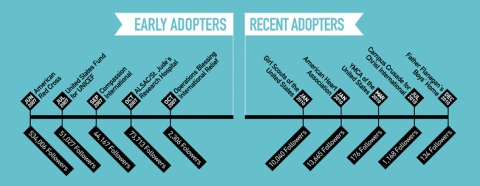
Infographic: How the Top 50 Nonprofits Do Social Media
[Source: craigconnects, October 13, 2011]
I get asked a lot if nonprofits are using social media effectively. After taking a look at the Nonprofit Times list of 100 top nonprofits based on income, the craigconnects team decided to look at who was proactively and effectively utilizing social media in August and September of 2011. Do the highest earning nonprofits use social media the most effectively? How are people responding and interacting? The deal is with social media use on the rise, we decided to check this out and created an infographic to show the results.
A few cool things we figured out:
- 92% of the top 50 nonprofits have at least 1 social media presence on their homepage.
- The most followers that an organization has on Twitter is 840,653 (PBS)…
- …but on the other hand, the organization following the most people is following 200,522 (The American Cancer Society)!
- The American Red Cross was the first organization on the list to create a Twitter account.
- Food for the Poor is the most talkative organization on Facebook, and has posted 220 posts over the course of 2 months.
- The organization with the highest net income, the YMCA, only posted 19 times to Facebook in 2 months, but has over 24,000 fans.

Is it really first come, first serve? It took some organizations no time at all to jump on the social media bandwagon, as early as 2007, but others were a little bit behind. So the question is, does that impact the number of followers they have? The slogan quality over quantity seems rather fitting. For example, PBS has the most followers on Twitter but is in the bottom quarter bracket on the list of net income.
So you have friends, and you have followers. But what factors determine how often an organization's Facebook post will generate a like or a comment? Can money buy engaged friends on social networks? We took a look at the average amount of responses (combined likes and comments) each organization was getting per post, and St. Jude's Children's Hospital was definitely in the lead, yet ranked 29 on the income list.
For the record, we checked out their Twitter Grader score, which provided us with all the possible information we could need about their Twitter account. We discovered how many times they tweeted over the course of 2 months and took look at their Facebook standing: we utilized AllFacebookStats.com to capture the number of Facebook fans the nonprofit had, how many times they had posted over the course of 2 months (August 2011-September 2011), and the likes and comments they had received on their posts over that time period. It was these metrics that led us to determine just how efficiently the top 50 nonprofits utilize social media, and whether income actually has an effect.
The bottom line is that income does not increase a nonprofit's visibility and interactions in the social media world. Some of the most social-media-savvy organizations are in the bottom quarter bracket in terms of income, yet they are clearly active on social media. Social media is about fostering conversations and interactions. These are the keys to keeping up in the fast-paced arena of social networks.


